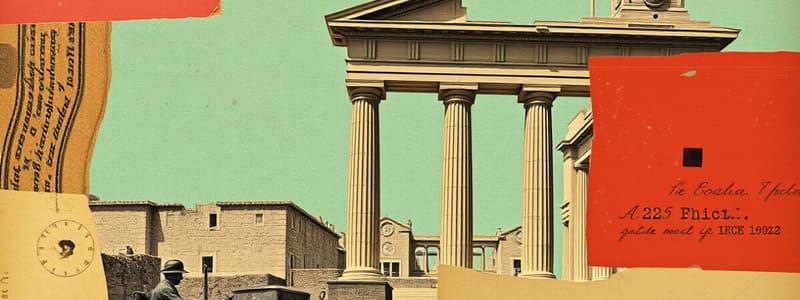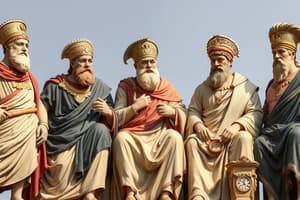Podcast
Questions and Answers
What was the significance of the Pax Romana for the Roman Empire?
What was the significance of the Pax Romana for the Roman Empire?
- It initiated a time of relative peace and stability within the empire. (correct)
- It marked a period of military expansion and conquest.
- It led to a totalitarian regime under emperor Augustus.
- It resulted in economic turmoil and widespread inflation.
Which of the following actions was taken by Diocletian to address problems within the Roman Empire?
Which of the following actions was taken by Diocletian to address problems within the Roman Empire?
- He promoted a policy of religious pluralism.
- He aggressively expanded the empire’s territory to increase resources.
- He divided the empire into smaller administrative units. (correct)
- He increased the power of the Senate to stabilize politics.
Which event marked the beginning of the Byzantine Empire?
Which event marked the beginning of the Byzantine Empire?
- The fall of the Western Roman Empire in 476 AD.
- The founding of Constantinople in 330 AD.
- The reign of Justinian starting in 527 AD. (correct)
- The Great Schism of the Church in 1054 AD.
What was one major change brought about by Constantine in the Roman Empire?
What was one major change brought about by Constantine in the Roman Empire?
Which individual is credited with making Christianity the official religion of the Roman Empire?
Which individual is credited with making Christianity the official religion of the Roman Empire?
What role did aqueducts play in the Roman Empire, and how did they impact daily life?
What role did aqueducts play in the Roman Empire, and how did they impact daily life?
Describe how inflation affected the economy of the Roman Empire during its decline.
Describe how inflation affected the economy of the Roman Empire during its decline.
What significant action did Octavian 'Augustus' take that transformed the Roman Empire?
What significant action did Octavian 'Augustus' take that transformed the Roman Empire?
How did Constantinople's status as the capital of the Byzantine Empire influence its development?
How did Constantinople's status as the capital of the Byzantine Empire influence its development?
In what ways did Jesus' teachings impact the Roman Empire and contribute to the rise of Christianity?
In what ways did Jesus' teachings impact the Roman Empire and contribute to the rise of Christianity?
Identify two methods Diocletian used to try to save the Roman Empire from decline.
Identify two methods Diocletian used to try to save the Roman Empire from decline.
What was the significance of the Great Schism in the Church, and how did it reflect broader cultural changes?
What was the significance of the Great Schism in the Church, and how did it reflect broader cultural changes?
How did the expansion of the empire contribute to its decline?
How did the expansion of the empire contribute to its decline?
Discuss one aspect of Roman culture that had a lasting impact on later civilizations.
Discuss one aspect of Roman culture that had a lasting impact on later civilizations.
Compare one similarity and one difference between the Roman and Byzantine Empires.
Compare one similarity and one difference between the Roman and Byzantine Empires.
Flashcards are hidden until you start studying
Study Notes
Vocabulary
-
Aqueduct: A structure built to transport water from one location to another, crucial for urban development.
-
Deify: To elevate someone to divine status, common practice for emperors in Rome.
-
Pax Romana: A 200-year period of relative peace and stability across the Roman Empire, allowing for economic growth and infrastructure development.
-
Inflation: Economic condition characterized by rising prices, which weakened the Roman economy.
-
Barbarian: Term used by Romans to describe tribes outside their empire, many of whom invaded Roman territories.
-
Constantinople: The capital city of the Byzantine Empire, established by Emperor Constantine and a major center of trade and culture.
Key Figures
- Octavian “Augustus”: First Roman emperor; established the principate and led Rome into the Pax Romana.
- Commodus: Controversial emperor; known for his erratic behavior and focus on personal pleasure, contributing to decline.
- Caracalla: Issued the Edict of Caracalla, granting citizenship to all free men in the empire; known for his violent reign.
- Maximinus Thrax: Soldier-emperor; characterized by his brutal military campaigns and heavy taxation, which burdened citizens.
- Jesus: Born into the Roman Empire; founded Christianity, a major religion that spread throughout the empire.
- Constantine: First Christian emperor; established Constantinople and promoted the Edict of Milan, which granted religious freedom.
- Justinian: Byzantine emperor; known for his legal reforms and efforts to consolidate and expand the empire.
- Diocletian: Implemented reforms for stability; divided the empire into dioceses, established a price edict to control inflation, and strengthened military defenses.
Roman Culture + Practical Achievements
- Roman culture emphasized architecture (e.g., the Colosseum, Roman baths), engineering (e.g., roads, sewage systems), and law (e.g., Twelve Tables), influencing future civilizations and modern legal systems.
Causes and Effects
- Pax Romana: Brought stability and economic prosperity during the empire; allowed for cultural exchange and infrastructure development.
- Empire Land Expansion: Increased wealth and diversity but led to challenges in governance and military overextension.
- Inflation: Economic instability caused social unrest and contributed to the empire's decline.
- Foreign Relations: Conflicts with barbarian tribes strained resources and led to invasions.
- Capital Moved to Constantinople: Shifted focus of power and resources to the East, weakening the Western Empire.
- Byzantine Empire Begins (527 AD): Emerged as a continuation of Roman governance in the East, preserving Roman law and culture.
- Great Schism: Split between Eastern Orthodox and Roman Catholic churches in 1054, leading to religious and cultural fragmentation.
Reflection Questions
-
Various factors contributed to the decline of the Roman Empire, including military overspending, political corruption, economic inflation, and cultural shifts towards Christianity, which altered traditional values. External pressures from barbarian invasions also played a significant role, destabilizing regions and leading to territorial losses.
-
The Roman and Byzantine Empires shared similarities in governance, law (e.g., Roman Law), and culture, maintaining Roman heritage. However, they diverged significantly in religion (paganism vs. Christianity), language (Latin vs. Greek), and administrative structure, particularly as the Byzantine Empire became more autocratic under emperors.
Vocabulary
-
Aqueduct: A structure built to transport water over long distances, showcasing Roman engineering.
-
Deify: The act of elevating someone to divine status, often applied to Roman emperors.
-
Pax Romana: A long period of relative peace and stability across the Roman Empire, lasting approximately 200 years.
-
Inflation: Economic phenomenon characterized by rising prices and decreased purchasing power, significant in late Roman Empire.
-
Barbarian: Term used by Romans to describe various tribes and groups outside the Roman Empire; often perceived as uncivilized.
-
Constantinople: The capital city of the Byzantine Empire, established by Emperor Constantine, serving as a pivotal cultural and political center.
Key Figures
- Octavian “Augustus”: First Roman emperor; established the Roman Empire and initiated the Pax Romana.
- Commodus: Controversial emperor known for his erratic behavior and prioritizing personal indulgences over effective governance.
- Caracalla: Implemented the Antonine Constitution, granting citizenship to many free men in the empire.
- Maximinus Thrax: Notable for being a military leader with a focus on expanding the empire's borders; ruled during political instability.
- Jesus: Born within the Roman realm; his teachings formed the basis of Christianity, which spread widely throughout the empire.
- Constantine: Famous for converting to Christianity, establishing it as the empire's official religion, and founding Constantinople.
- Justinian: Byzantine emperor renowned for codifying Roman law (Corpus Juris Civilis) and expanding the empire’s territory.
- Diocletian: Introduced reforms including the division of the empire into the Eastern and Western Roman Empire and implemented price controls.
Roman Culture + Practical Achievements
- Cultural Contributions: Roman art, architecture, and literature influenced subsequent Western civilizations and continue to be foundational in modern culture.
- Engineering Innovations: Contributions such as roads, aqueducts, and public buildings improved urban life and military logistics, promoting trade and connectivity.
Cause and Effects
-
Cause (during Empire): Military expansion led to stretched resources and vulnerability of borders.
-
Effect (during Empire): Increased reliance on mercenaries weakened loyalty among troops, leading to military instability.
-
Cause (after the Empire ended): Economic issues like inflation and taxation caused discontent among citizens.
-
Effect (after the Empire ended): The weakening of urban centers resulted in a shift towards a more rural society.
-
Pax Romana: Provided peace that allowed for economic growth but also fostered complacency and inability to address emerging threats.
-
Empire Land Expansion: Expanded territories placed strain on administration but increased wealth through plunder.
-
Inflation: Economic decline in the late empire severely impacted trade and stability.
-
Foreign Relations: Initial successes in diplomacy became strained due to external threats from barbarian tribes.
-
Capital moved to Constantinople: Shifted focus to the East; allowed the Byzantine Empire to thrive and evolve separately from the West.
-
Byzantine Empire begins in the East in 527 AD: Marked a continuation of Roman traditions through a new lens of governance and culture.
-
Great Schism in the Church: Division between Roman Catholic and Eastern Orthodox churches influenced religious and political landscapes.
Reflection Questions
-
Factors Leading to Decline of the Roman Empire: Included political corruption, economic troubles, military defeats, and increasing reliance on foreign troops. Notable events include invasions by barbarian tribes, internal strife, and the division of the empire. Climate changes affected agriculture leading to food shortages.
-
Compare and Contrast Roman and Byzantine Empires: Both empires shared a legacy of Roman law, governance practices, and cultural traditions. Major differences include language (Latin in Rome, Greek in Byzantium), religious orientation (polytheism/Christianity in Rome vs. predominantly Christianity in Byzantium), and administrative structure, with Byzantium maintaining a more centralized authority under a theocratic rule.
Studying That Suits You
Use AI to generate personalized quizzes and flashcards to suit your learning preferences.




